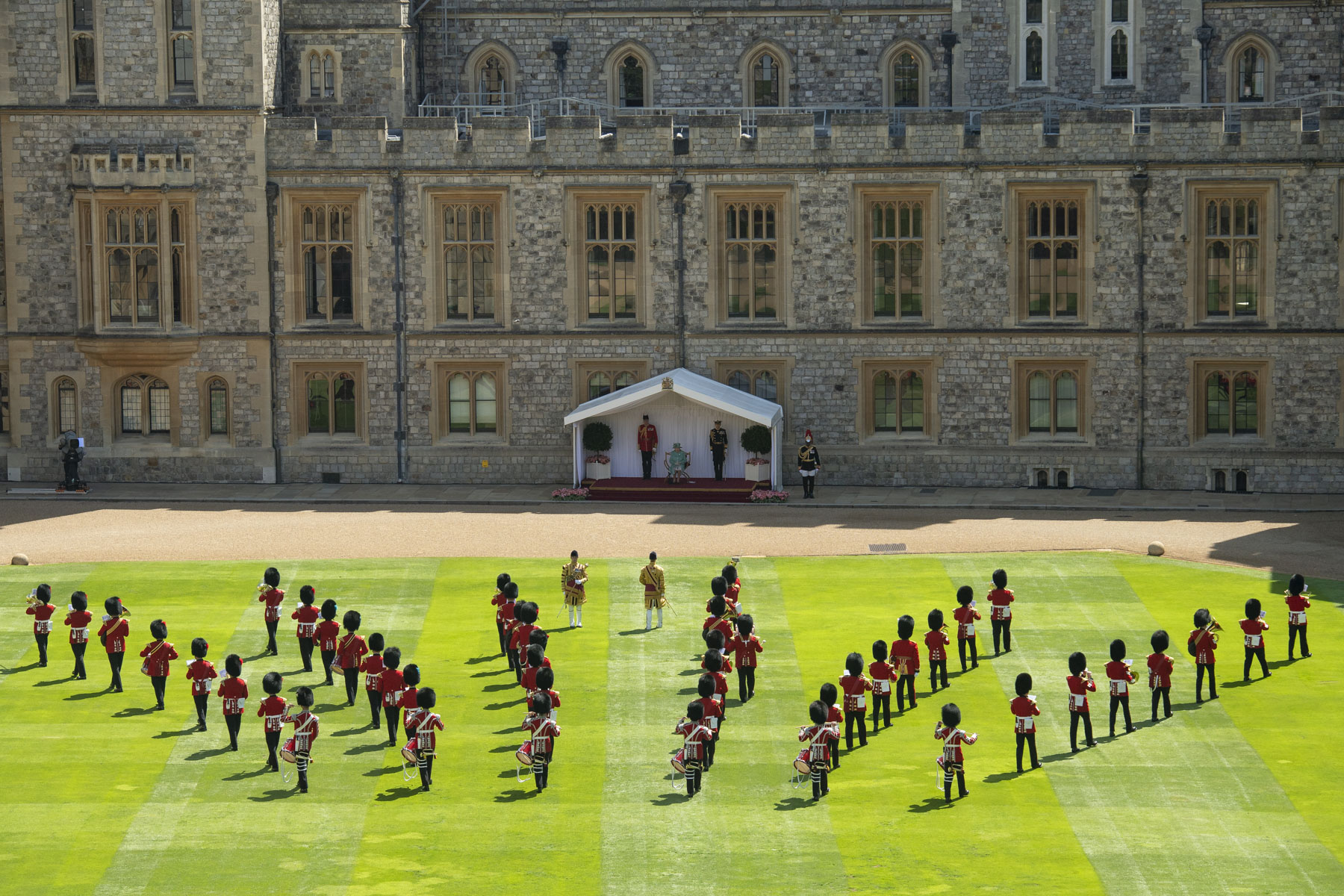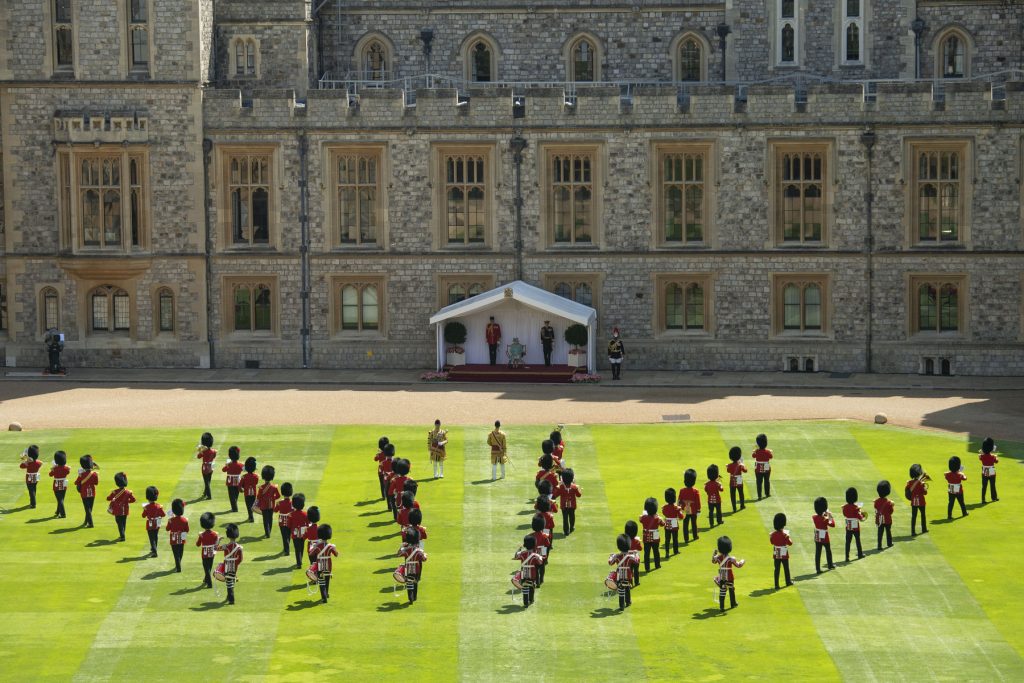
Throughout the pandemic, Guardsmen from the Household Division have continued to guard Windsor Castle, Buckingham Palace, St James’ Palace and the Tower of London, in addition to forming a COVID Support Force. They paid tribute to Her Majesty on the occasion of her Official Birthday, the Windsor Castle Guard, provided by the 1st Battalion Welsh Guards, turned out in the Quadrangle at Windsor Castle, accompanied by a reduced Massed Band of the Household Division. Ordinarily, Guardsmen would be shoulder-to-shoulder, enabling them to maintain ‘dressing’ or staying in line with one another, but in keeping with government COVID-19 guidelines on social distancing, each Guardsman is now tasked with standing 2.2m apart, measured by three turns of the pace stick.
The special ceremony for Her Majesty was commanded by Lieutenant Colonel Henry Llewelyn-Usher and lasted approximately 20 minutes. Music included many stirring Welsh favourites and was conducted by Lieutenant Colonel Simon Haw. An event of this nature has not happened in Windsor for the Sovereign’s birthday since 1895, and on Saturday the Household Division demonstrated new ceremonial drill moves that have been developed in order to deliver the ceremonial standards for which they are recognised around the world while conforming to strict social distancing guidelines. Immediately following the ceremony, the Windsor Castle Guard returned to the guardroom to resume their guard duty.
Soldiers were chosen due to the fact they are either living in the Windsor area, on duty at the Castle, or based in Barracks nearby, so limiting the amount of travel required.
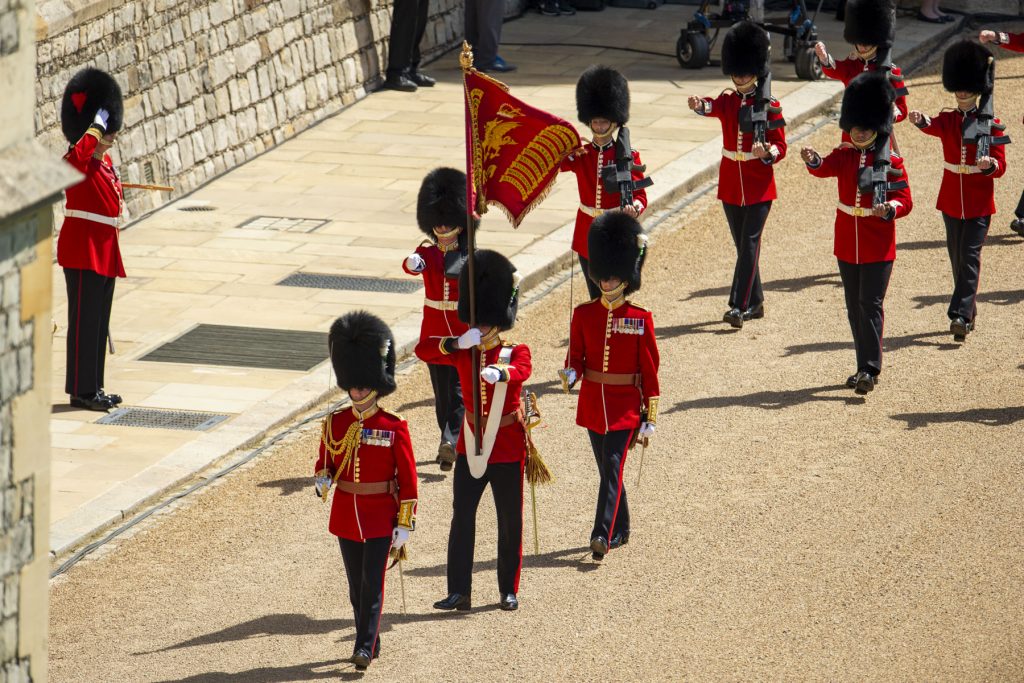
Garrison Sergeant Major Warrant Officer Class 1 Andrew Stokes has masterminded the design of what was a unique ceremony, and overseen the training, much of which initially incorporated virtual techniques. He said: “The Army teaches individuals many skills, but one of the greatest is teamwork, and this parade is a marvellous display of that: a collaboration of ideas and new thinking to celebrate the leadership of the Sovereign on her official birthday. With fewer people on parade there is no hiding place, there never is, and only the highest standard is acceptable, but more spacing between individuals means that there is also no room for errors, and so the soldier has to really concentrate on their own personal drill, reaction to orders, dressing and social distancing”.
Lance Corporal Chusa Siwale, aged 29, from Zambia, fulfilled the role of Lone Drummer for the ceremony, and delivered the ‘Drummer’s Call’ to instigate the colour being ‘Trooped’ through the ranks. A soldier first, he is part of the Welsh Guards’ assault pioneer platoon and deployed to Afghanistan in 2018 as a Force Protection Commander where he was awarded the Exemplary Leadership Award from the Commanding Officer. He has since completed his Class 1 Drummers Course, finishing as top student on the course. Speaking about what it means to be the Lone Drummer on parade for the tribute, he said: “It is a huge privilege for me to be undertaking this key role in the parade at what is a very difficult time for the UK. Only four weeks ago I was involved with testing key workers for COVID-19 as part of the Welsh Guards’ contribution to the battle against the virus; now I am on parade performing in front of Her Majesty. This is a very proud day for me”.
Sergeant Christopher Rees, aged 32 from Maesteg, South Wales is the Drum Major of the Welsh Guards, responsible for members of the Corps of Drums within the Welsh Guards, who are also soldiers in the Battalion’s assault pioneer platoon, providing crucial support to the rifle companies on training exercises and operations. Playing a key role in the tribute, he said: “This Official Birthday tribute is particularly special, having not taken place at Windsor Castle in over 120 years. To be Drum Major for the occasion is a real privilege that I will remember throughout my military career”.
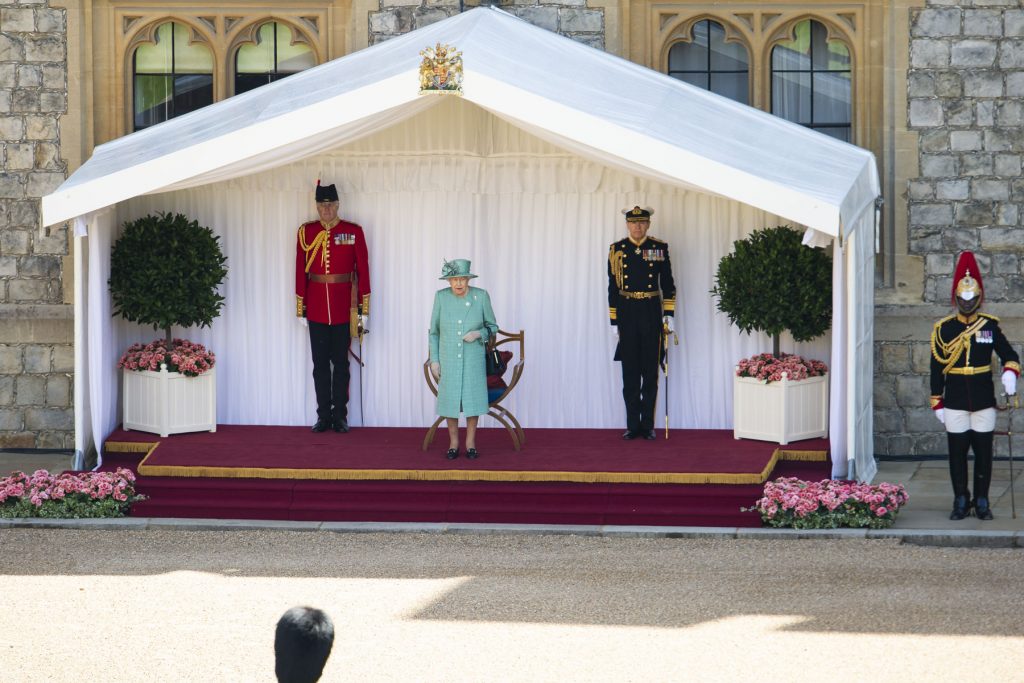
Major General Christopher Ghika commands the Household Division and is also currently the Joint Military Commander for London commanding all military support to the civil authorities in London in response to the Coronavirus pandemic. Among other tasks, this assistance has entailed logistical support to resilience partners to distribute key supplies and protective equipment, the provision of static and mobile testing centres and the construction of the NIGHTINGALE hospital at the ExCel Centre. He explained: “Trooping of the Colour has marked the official birthday of the Sovereign since 1748. The circumstances of the requirement to perform the Birthday Tribute at Windsor Castle this year are clouded in tragedy. The effects of Covid-19 have been devastating in terms of loss of life and the threatening of livelihoods of so many across the country. People have had to endure separation from loved ones, great uncertainty and the suspension of so much of what is special about our national life. This ceremony represents a unique opportunity – within the parameters that the current situation demands – to mark The Queen’s Official Birthday. The Welsh Guards and many of those on parade have recently been deployed within the United Kingdom as part of the nation’s response to the virus and so the context of the ceremony is particularly poignant.”
Sergeant Dan Evans, aged 38, from Bodmin, Cornwall, is a trumpet player in the Band of the Welsh Guards, performing in the ceremony. He said; “Playing for Her Majesty is always a privilege and something I count myself very lucky to be able to do as a musician in the British Army. My sister is a consultant anaesthetist at the Princess Alexander Hospital in Harlow and together with my brother in-law, set up a fund-raising campaign for the hospital staff that has raised over £60,000 so far. I would like to say a huge thank you to them and all the Country’s key workers for the work they are doing”.
Sergeant Rhys Rutledge, aged 34, from Colwyn-Bay, North Wales, is a platoon Sergeant in the Welsh Guards and a member of the Escort to the Colour (ceremonial flag) on parade. He said; “My role on parade is to escort and protect the Colour; the utmost privilege for a senior non-commissioned officer. I have deployed on overseas exercises as well as on operations to Afghanistan on several occasions, providing me with some incredible experiences within the British Army, but my role in this tribute will mark the pinnacle of my military career to-date”.
Colour Sergeant Richard Lorimer, aged 38, from Ballymena, Northern Ireland, a flute player in the band of the Scots Guards said; “Playing in the band of the Scots Guards alongside my colleagues in the Household Division makes me extremely proud to be part of the British Army. We are soldiers as well as musicians, providing real depth to the British Army’s capability. We have been on standby to assist with military aid to the civil authorities throughout this difficult time, with our colleagues in the Welsh Guards who are on parade today involved in testing only a few weeks ago. On a personal note, my brother-in-law is an A&E Consultant who has been at the forefront of the response in Northern Ireland and my sister is about to return back to work in the NHS following maternity leave. To them and all who have supported the nation throughout this difficult time; thank you”.
Warrant Officer Class 1 Michael Parry, aged 39, from LLifaen, North Wales, the Regimental Sergeant Major of the 1st Battalion Welsh Guards, said; “Some of the soldiers involved in the Official Birthday tribute have been on overseas exercises, operational deployments, and most recently, involved with testing key workers and members of the public for COVID-19 across London. The British Army’s ability to move from an operational role as soldiers first, to our ceremonial duties, demonstrates the professionalism and our ability to adapt to any situation; which is why I think we are the best Army in the World. As the senior soldier in the Battalion, I am incredibly proud of all of the soldiers of the Welsh Guards involved in the Official Birthday tribute demonstrating their strength and ability to fulfil their duties in difficult times”.
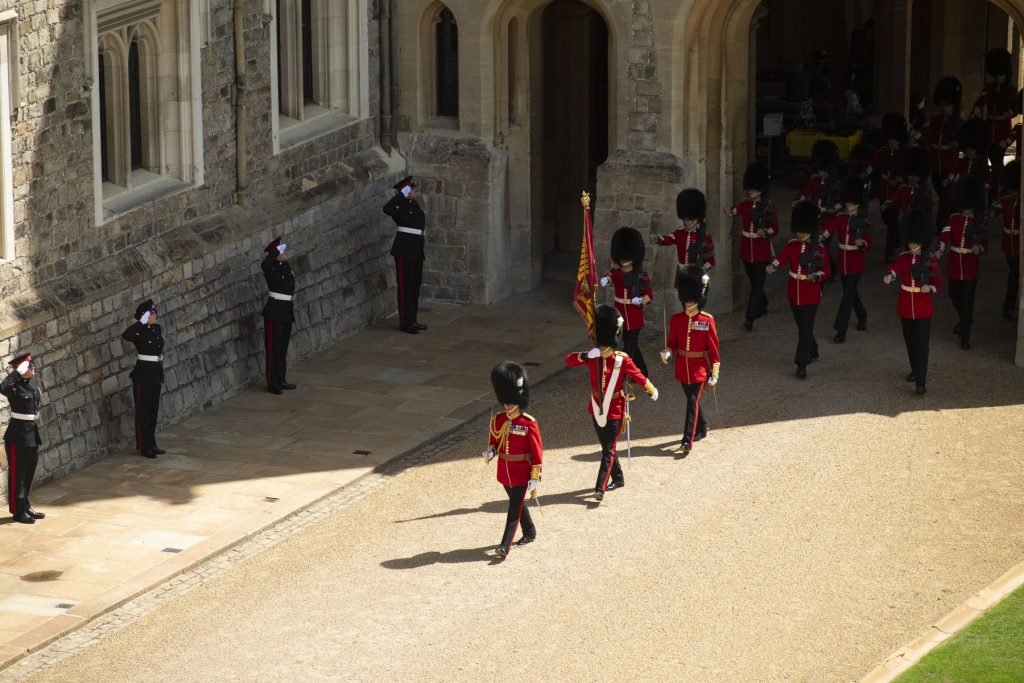
Lieutenant William (Billy) Richardson, aged 25, from Deal in Kent, is a platoon commander in 1st Battalion Welsh Guards and has the honour of carrying the Battalion’s Colours on parade in his role as the Ensign to the Colour. His father, Oliver, served in the Welsh Guards during the 1980s and was aboard the RFA Sir Galahad when it was bombed during the Falklands War in 1982. He said; “I grew up in London and only a few years ago was running a pub in Islington with my brother. Since joining the Welsh Guards, I have deployed to the Falklands on a training exercise, as well as assisting with the recent COVID-19 testing. To go from that footing to demonstrating our ceremonial duties and capability is important for the soldiers of the Household Division. It is every Guards Officer’s dream to be selected to be the Ensign on parade and I feel hugely privileged to be part of this unique Official Birthday celebration”.
Lance Corporal Stephen Shepherd, saxophonist from the Band of the Welsh Guards who performed on the Queen’s parade, said: ‘It is a real honour to be involved with the birthday tribute to Her Majesty The Queen; to be able to perform for both Her and the general public in such a difficult period is a real pleasure”.
A recording of the music performed at the ceremony by the HDiv Bands is available for free download to the public after 11am on 13th June 2020 at
www.householddivision.org.uk/hmtribute20
COVID-19 Context
In March 2020, the Army was called upon to support the national response to the COVID-19 pandemic. It provided a breadth of support to public services, from testing, logistics and engineering to medical support and transport. This support was fully integrated with both public and private sector organisations, with a unified purpose. In preparation for the delivery of a variety of tasks, soldiers from the Household Division were re-rolled into a COVID Support Force (CSF); the Welsh Guards were predominantly used to support the testing programme at both regional and mobile testing sites (Chessington, Portsmouth, Wembley, and Milton Keynes). Like the rest of the country, the Household Division has had to rapidly adjust to the new environment created as a result of the COVID-19 Pandemic. As HQ LONDON DISTRICT re-roled to form the Joint Military Command (London), its soldiers and military musicians have maintained their capability by conducting theory training, Physical Training via Zoom and Strava, and continued to plan and prepare for core commitments despite these unprecedented circumstances.
The Household Division

The Household Division of the British Army comprises the two Mounted Regiments of the Household Cavalry: The Life Guards and The Blues and Royals, and the Five Regiments of Foot Guards: the Grenadier Guards, Coldstream Guards, Scots Guards, Irish Guards and Welsh Guards. The King’s Troop, Royal Horse Artillery, are Household Troops of Her Majesty The Queen. The Regiments are linked with and closely supported by the reserve companies of the London Regiment. Each regiment has a distinguished service record that extends back across generations. The Guards trace their earliest roots back to the 17th Century and the forces raised by Charles II in exile or to those who fought for Parliament in the English Civil War. Guards Regiments have served continuously as the Sovereign’s personal guard since the Restoration of King Charles II in 1660 and have participated in every major campaign conducted by the British Army ever since. Members of the Household Division continue to serve both on operations and on ceremonial duties in London.
Socially Distanced Ceremonial
Ordinarily, Guardsmen would be shoulder-to-shoulder, enabling them to maintain ‘dressing’ or staying in line with one another, but in keeping with government COVID-19 guidelines on social distancing, each Guardsman is now tasked with standing 2.2m apart, measured by three turns of the pace stick. This measure has been imposed since the beginning of preparations and has been (literally and figuratively) drilled into the Guardsmen. To maintain dressing in these circumstances is an achievement that should not be underestimated.
Two unique elements of the ceremony are:
1. “Feathering”. To move a band in a confined space they would usually Counter March to change direction, this is not possible under COVID-19 restrictions and therefore the Household Division has invented the Feathering technique, so called because aerially it resembles the Prince of Wales’s feathers, which is rather apt considering it is the Welsh Guards on parade and their Colonel is the Prince of Wales. Using the adopted method allows the band to turn 180 degrees and maintain individual distances.
2. The Colour being trooped through the ranks has become synonymous with the Queen’s Birthday Parade, and so during this celebration it was very important to try and include this. The Household Division has been able to do so by adapting the normal procedure and increasing space between the ranks, unfortunately they were not able to invent a solution for the Colour to be handed over by the Regimental Sergeant Major to the Ensign without breaking the social distancing rules, however the ‘Sergeant Major will still draw his sword on parade and accompany the Escort Party as the Colour is trooped, symbolic of him drawing his Arms to protect the Colour.
The Welsh Guards
Saturday 13th of June 2020 marked the 11th occasion that the Battalion has been formally involved in a State Celebration of Her Majesty’s Birthday Parade. It is easy to distinguish between the Regiments of Foot Guards as the buttons on the tunics are spaced to reflect their order of seniority. The Welsh Guards have buttons arranged in groups of five and a plume in their bearskin that is green and white echoing the embroidered leek on their tunic collars. The Regiment was the last of the five Foot Guards Regiments to be formed; only coming into existence in 1915 by Royal Warrant of King George V and order of Earl Kitchener the Secretary of State for War. Within a few months of its creation the new unit was not only on mounted guard duty at Buckingham Palace but also sailed for France to engage in the actions of the Great War. The 1st Battalion went on to serve in Northern Ireland, Palestine, Egypt, Germany, Aden, Cyprus and Belize, and was famously part of the Task Force that fought in the Falklands campaign in 1982. Since then it has been deployed on two tours of Bosnia and tours of Northern Ireland, Iraq, Kosovo and Afghanistan.
In the past 18 months, 1st Battalion Welsh Guards has exemplified versatility and adaptability; returning from an eight-month tour of Afghanistan (Op TORAL) in December 2018. They have since balanced a relentless Public Duties commitment with a focussed eye on training progression towards deployment to Iraq in 2021. This included a four-month deployment to the Falkland Islands, a six-week exercise in the Jungles of Belize and various Staff training exercises. In March 2020 the Battalion switched focus to delivering the Queen’s Birthday Parade, a task which demands months of logistic preparation and training to deliver the highest standards for Her Majesty. As preparations began, the Welsh Guards were re-roled into a COVID Support Force (CSF) on 26th March, swiftly re-orientating to the emerging threat in rapidly changing circumstances. The Battalion committed Guardsmen primarily to the Regional Testing Centre at Chessington, with support provided at Portsmouth, Milton Keynes and Wembley too. With CSF commitments now reduced, the Welsh Guards are preparing to deliver a parade to mark Her Majesty’s Official Birthday like no other; this parade has been substantially changed to incorporate Government Social Distancing direction. The Guardsmen have risen well to this new challenge. They will return to COVID testing later this month and then focus will then shift back to the development of core capabilities, and completion of the infantry training events in the first quarter of 2021, before deploying to Iraq in June 2021.
Trooping The Colour
The word ‘Colour’ refers to the regimental flags of the British Infantry. Flags have been used as rallying points for military units since the time of the Kings of Babylon. In 1707, during Queen Anne’s reign, the number of Colours was reduced to two per regiment. Colours were last carried into action by the 58th Foot in South Africa in 1881. Up until that time they witnessed all the varying fortunes of their Regiment and were often torn by enemy fire, acquiring an almost religious significance. The Colours are still highly regarded today and are always carried by an officer and accompanied by an armed escort. The Welsh Guards have 47 Battle Honours, of which 21 are displayed on The Colours. Battle Honours are awarded by the Sovereign in recognition of a particular Regiment’s involvement or contribution to a battle. The Regiment’s first Battle Honour was awarded for its notable participation in the Battle of Loos in 1915 and its most recent Battle Honour was awarded for the action the Regiment saw in the Falklands in 1982. The Queen’s Colour on parade today was presented to 1st Battalion Welsh Guards by Her Majesty The Queen at Windsor Castle on 30 April 2015, which was also the Regiment’s Centenary year.
State Ceremonial Musicians
For hundreds of years the Bands of the Household Division have been at the forefront of military music. Renowned for their performances at high profile engagements from The Queen’s Birthday Parade and the Beating of the Retreat on Horseguards Parade in the summer, to the National Act of Remembrance at the Cenotaph and the Royal British Legion Festival of Remembrance at the Royal Albert Hall in November – the Bands of the Household Division are an iconic part of our national heritage. Music for the various State Ceremonial Events that take place throughout the year is provided by the six bands and one orchestra of the Household Division. These comprise the Band of the Household Cavalry, the Bands of the Grenadier, Coldstream, Scots, Irish, Welsh Guards and the Countess of Wessex’s String Orchestra. All the Bands of the Household Division perform for regular duties such as the Changing of the Guard, including the Band of the Household Cavalry which parades dismounted. For larger events such as Trooping of the Colour, the Band of the Household Cavalry performs mounted. The Countess of Wessex’s String Orchestra provides musical support for occasions such as Investitures, State Banquets and other events held within the Royal Palaces.
Historical precedent
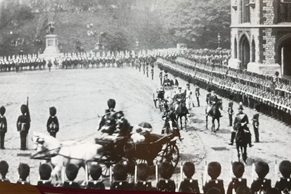
In 1895 the Queen’s Birthday Parade was held, uniquely, on two consecutive days at Windsor and in London and the Colours of a Battalion of the Scots Guards was trooped at each. Queen Victoria was at Windsor for her 76th Birthday and made an entry in her diary for 24th May:
‘After looking at my presents, we breakfasted, and at 11.30 the Trooping of the Colours took place in the Quadrangle. I was present in my carriage with Lenchen (Princess Christian) and Louise, Beatrice and Thora (Princess Helena Victoria) being in the next one. It took an hour and was a very pretty sight. The Bands played extremely well’.
Two Squadrons of the 2nd Life Guards with two Standards and the Band were formed up on the West side of the Quadrangle. Colonel the Viscount Falmouth, the Field Officer in Brigade Waiting and Lieutenant Colonel Sir Simon Lockhart, 1st Life Guards, The Silver Stick in Waiting were in attendance on the Queen.
By astonishing coincidence, the name of The Silver Stick in Waiting attending the Windsor ceremony on 13th June 2020 was Colonel Crispin Lockhart.
All images: Crown Copyright 2020.

